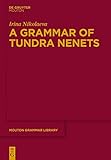A Grammar of Tundra Nenets / Irina Nikolaeva.
Material type: TextSeries: Mouton Grammar Library [MGL] ; 65Publisher: Berlin ; Boston : De Gruyter Mouton, [2014]Copyright date: ©2014Description: 1 online resource (511 p.)Content type:
TextSeries: Mouton Grammar Library [MGL] ; 65Publisher: Berlin ; Boston : De Gruyter Mouton, [2014]Copyright date: ©2014Description: 1 online resource (511 p.)Content type: - 9783110320473
- 9783110373295
- 9783110320640
- 494.4
- PH3816.1
- online - DeGruyter
- Issued also in print.
| Item type | Current library | Call number | URL | Status | Notes | Barcode | |
|---|---|---|---|---|---|---|---|
 eBook
eBook
|
Biblioteca "Angelicum" Pont. Univ. S.Tommaso d'Aquino Nuvola online | online - DeGruyter (Browse shelf(Opens below)) | Online access | Not for loan (Accesso limitato) | Accesso per gli utenti autorizzati / Access for authorized users | (dgr)9783110320640 |
Browsing Biblioteca "Angelicum" Pont. Univ. S.Tommaso d'Aquino shelves, Shelving location: Nuvola online Close shelf browser (Hides shelf browser)

|

|

|

|

|

|

|
||
| online - DeGruyter Digital Whoness : Identity, Privacy and Freedom in the Cyberworld / | online - DeGruyter On Explaining Existence / | online - DeGruyter Logic in Orthodox Christian Thinking / | online - DeGruyter A Grammar of Tundra Nenets / | online - DeGruyter The Trope Bundle Theory of Substance : Change, Individuation and Individual Essence / | online - DeGruyter Philosophical Deliberations / | online - DeGruyter Humean Libertarianism / |
Frontmatter -- Acknowledgment -- Table of contents -- Abbreviations -- Chapter 1. Introduction -- Chapter 2. Phonology -- Chapter 3. Grammatical classes -- Chapter 4. Nominal inflection -- Chapter 5. Verbal inflection -- Chapter 6. Clitics and multi-based affixes -- Chapter 7. Noun Phrases -- Chapter 8. Adjectival, adverbial and postpositional phrases -- Chapter 9. Syntax of simple clauses -- Chapter 10. Valence patterns and alternations -- Chapter 11. Non-verbal predicates -- Chapter 12. Non-declarative clause types and negation -- Chapter 13. Overview of dependent clauses -- Chapter 14. Relative clauses -- Chapter 15. Complement clauses -- Chapter 16. Adverbial clauses -- Chapter 17. Anaphoric relations -- Chapter 18. Coordination -- Chapter 19. Texts -- References -- Index
restricted access online access with authorization star
http://purl.org/coar/access_right/c_16ec
The book is the first substantial description of Tundra Nenets, a highly endangered Uralic language spoken in Western Siberia and the north of European Russia, destined for the international linguistic community. Its purpose is to provide a thorough documentation of all of the major grammatical phenomena in the language. The grammar particularly emphasizes the description of syntax, because this has traditionally been a very neglected area of Nenets studies. Many syntactic aspects have not received a systematic treatment in the existing literature or have not been addressed at all. Since the existing works are not easily available, incomplete, or idiosyncratically presented, Tundra Nenets syntax has played little or no role in the considerations of modern linguists, whether more descriptively or theoretically inclined. The book is largely descriptive: it is not intended to address theoretical questions per se and the description is not meant to be formulated within a particular framework. However, it identifies and discusses issues which are of broad typological and theoretical interest. The description is richly exemplified. Most of the cited examples are the result of fieldwork conducted by the in various locations. They are sentences produced by native speakers either spontaneously or elicited in response to questions posed in Russian. Other examples are excerpts from original texts.
Issued also in print.
Mode of access: Internet via World Wide Web.
In English.
Description based on online resource; title from PDF title page (publisher's Web site, viewed 25. Jun 2024)


